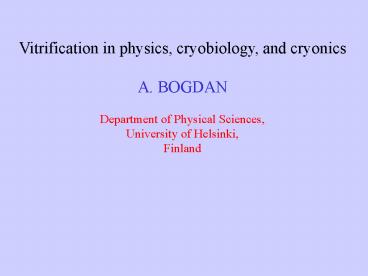Vitrification in physics, cryobiology, and cryonics - PowerPoint PPT Presentation
1 / 31
Title:
Vitrification in physics, cryobiology, and cryonics
Description:
Cryobiology is the study of the effects of ... Cryobiology tries to understand how nature has ... Additives, which are used in cryobiology and cryonics or ... – PowerPoint PPT presentation
Number of Views:798
Avg rating:3.0/5.0
Title: Vitrification in physics, cryobiology, and cryonics
1
Vitrification in physics, cryobiology, and
cryonics A. BOGDAN Department of Physical
Sciences, University of Helsinki, Finland
2
- Contents
- Introduction
- - what are cryobiology and cryonics ?
- - Vitrification in physics
- - freezing temperature depends on size
- - calorimetric study of freezing, melting,
and - vitrification (glass transition)
- - freezing on warming
- - what are cryoprotectants ?
- Vitrification in biological systems
- - devitrification problem
- - Conclusions
3
- Cryobiology is the study of the effects of
freezing and low temperatures on living
systems. - Nature has had millions of years to
adapt living organisms to the stress of low
temperature. - Cryobiology tries to understand
how nature has reconciled the physical and
biological principles for surviving
organisms at low temperature. - Cryonics is
the preservation of legally dead humans or
pets at liquid nitrogen temperature in the hope
that future science can restore them to
life. - Cryobiology and cryonics stand at the
interface between physics and biology.
4
Vitrification in physics Calorimetric study
5
Freezing temperature of pure water drops depends
on size
6
Addition of solutes to water additionally
reduces freezing temperature
7
Example of calorimetric curves of the freezing,
phase separation, and melting of emulsified
solution drops
8
Example showing how increasing concentration of
solute (H2SO4) reduces freezing temperature
until vitrification occurs.
9
- - Vitrification is a process of converting
aqueous solutions - into the glassy (amorphous) state on cooling
escaping - freezing. The formation of ice is prevented
by - - very rapid cooling rate
- - the introduction of some agents that
suppress - the formation of ice.
- Additives, which are used in cryobiology and
cryonics or - produced naturally by organisms, are called
- cryoprotectants.
- Polar fishes and insects make antifreeze
proteins (ice - blockers) which prevent
- - the nucleation of ice
- - the growth of the already formed ice
- within the insect which is below its freezing
temperature.
10
Example of cooling sample without freezing.
Crystallization (freezing) and melting occur on
warming
Devitrification problem
11
Pure (black curves ) and seeded (red curves) with
fumed silica (SiO2) emulsified solutions behave
differently at low temperature
Devitrification problem
12
Vitrification in biological systems
13
1) Living tissue contains much of water
From http//www.alcor.org/Library/html/vitrificat
ion.html with
changes
14
2) Water is component of a cellular solution in
living tissue
15
3) When tissue is cooled below freezing
temperature, water molecules gather together and
form growing ice crystals
16
4) Growing ice expel other molecules from the ice
lattice to form a harmful concentrated solution
17
5) On a cellular scale, ice forms first outside
cells
Cell
18
6) Growing ice causes cells to dehydrate and
shrink
Ice
19
7) Finally cells are left damaged and squashed
between ice crystals. The damage is mostly
mechanical.
Extra-cellular Ice
20
- How to prevent the formation of
ice? - - Glycerol and sugar glucose are natural
cryoprotectants. - There a number of synthetic cryoprotectants.
- Concentrated cryprotectants are toxic.
21
8) Adding cryoprotectants to cellular solution
can prevent crystallization of water to ice
22
9) Instead of freezing, molecules just move
slower and slower as they are
cooled
23
10) Finally, at very low temperature, molecules
become locked in place and an amorphous solid is
formed. Water that becomes solid without freezing
is said to be "vitrified"
24
11) Cryoprotectants are added to biological
system before deep cooling
25
12) There is no damage to cells during cooling
because no ice is formed
26
13) Finally cells are vitrified and biological
time is stopped
27
14) Because no ice is formed, vitrification can
solidify tissue without structural damage
28
15) Entire organs can be solidified and stored at
low temperature. Scientists are working on ways
to reduce the toxicity of the cryoprotectants
used to make water vitrify to allow banking of
organs for transplantation. The toxicity that
still does occur with vitrification of human
organs will be reversible with future molecular
repair technology.
29
It is much easier to avoid ice crystallization
when cooling than prevent it when warming i.e.,
to avoid the devitrification problem. The above
frozen kidney cannot be revived if many cells
are killed on warming.
30
How to escape the devitrification
problem? Efficient and nontoxic ice blockers,
for example, synthetic anti-freeze proteins, will
strongly reduce the mechanical damages produces
by the devitrification problem in the living
tissue.
31
CONCLUSIONS
- Since cryobiology and cryonics are at the
interface between physics, chemistry, and biology
the knowledge of physical-chemistry lows is very
important. - While at present there is much uncertainty about
whether cryonics is justifiable, a personal
choice is still the governing force in the
matter.































